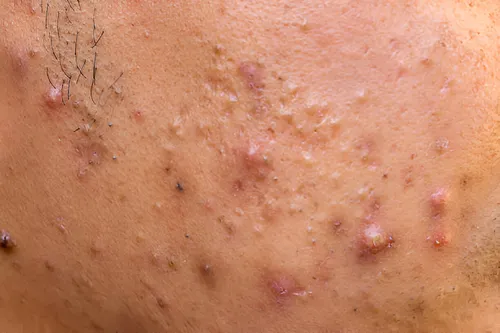What is Nodular Acne?
Nodular acne, also known as nodulocystic acne, is a severe form of inflammatory acne. This type of acne forms painful, pus-filled nodules deep under the skin. When skin pores become clogged with excess oil and dead skin cells, bacteria can enter the pores, leading to inflammation and swelling. Nodular acne is one of the most severe types of acne, often accompanied by intense pain and prone to scarring.
Difference Between Nodular Acne and Cystic Acne
Both nodular and cystic acne are deep, painful skin lumps that can lead to scarring. The main differences are:
– Cystic Acne: Filled with pus, appearing like a fluid-filled cyst.
– Nodular Acne: Harder, solid lumps without fluid inside.
Causes and Symptoms
Causes of Nodular Acne
The primary causes of nodular acne include:
– Age: Teenagers are most prone to developing nodular acne.
– Genetics: Family history of nodular acne.
– Hormonal Changes: Hormonal fluctuations during puberty, menopause, and stress can lead to nodular acne.
When skin pores are clogged with excess oil and dead skin cells, bacteria get trapped inside, causing deep skin inflammation and forming painful, red nodules.
Symptoms of Nodular Acne
Characteristics of nodular acne include:
– Red, swollen lumps under the skin that are painful or sensitive to touch.
– Sizes ranging from a pea to a coin.
– Sometimes forming crusts.
Common Areas Affected by Nodular Acne
Nodular acne commonly appears on the face due to its abundance of oil glands but can also occur on:
– Back
– Buttocks
– Chest
– Neck
– Shoulders
– Upper arms
Diagnosis and Treatment
Diagnosis Methods
Doctors can diagnose nodular acne through a skin examination.
Treatment Methods
Treating nodular acne is complex and usually requires three months or more, involving oral antibiotics and prescription-strength topical medications. Specific treatments include:
– Antibiotics: Creams, gels, solutions, and lotions to kill bacteria and reduce inflammation.
– Retinoids: Help remove dead skin cells.
Other treatment options include:
– Corticosteroid Injections: Quickly reduce large, painful nodules.
– Birth Control Pills or Spironolactone: For women, to lower hormone levels.
– Isotretinoin: Oral retinoid medications (e.g., Oratane, Roaccutane).
Prevention and Care
To prevent nodular acne, consider the following measures:
– Use a gentle cleanser twice daily and after sweating.
– Apply oil-free moisturizers if skin feels dry.
– Use non-comedogenic makeup and skincare products.
– Avoid sleeping with makeup on.
– Do not touch your face frequently.
– Refrain from squeezing or picking at acne.
– Wash your hair regularly to prevent oily hair from touching your face.
– Pay attention to diet, avoiding high-sugar and high-dairy foods that may exacerbate acne.
Nodular Acne Scars
Nodular acne on the chin, forehead, nose, back, shoulders, or chest can damage the skin and underlying tissue. As the lumps subside, the body tries to repair the damage. During this repair process, the body produces collagen, but if too much or too little collagen is generated, scars may form.
Factors increasing the risk of scarring include:
– Deep, severe acne: Swollen nodules are more likely to leave scars.
– Family history of acne scars: Genetics play a significant role in the appearance of acne and acne scars.
– Delayed acne treatment: The longer inflammatory acne goes untreated, the higher the risk of scarring.
– Squeezing or picking acne: Doing so increases inflammation and the risk of scarring.
If you have issues with nodular acne, it’s best to consult a doctor immediately to prevent future scarring.

